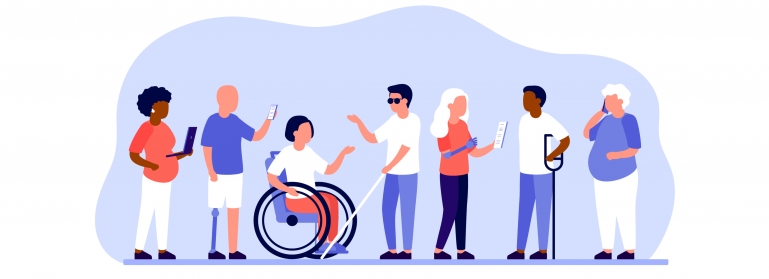Meet the Housing Stability Project

Meet the Housing Stability Project
Navigating the California rental market can be challenging for anyone, and heightened for people with disabilities.
To support people with disabilities facing housing-related issues, Disability Rights California (DRC) launched the Housing Stability Project (HSP), which bridges the gap for people with disabilities who have questions or problems with housing.
Rather than filing lawsuits, the HSP is made up of social workers, advocates, and attorneys who support clients by providing advice and sharing tools and services that they can take and use for themselves. The HSP focuses on the self-advocacy model, which emphasizes that people with disabilities and their support systems are best served through empowered support, rather than overpowering control. The HSP’s service model also emphasizes preventative legal help so that callers have access to the knowledge and resources that can avoid having their issues become emergencies that can be much more difficult to resolve.
The concept of housing stability looks at a variety of factors to measure how secure a person’s access to housing is—such as housing cost, permanence, comfort, safety, accessibility, and structural and functional adequacy.

“I think of housing stability as your ability to stay housed or get housed should not be something that is a major stressor in your life, and for most of our clients, it is,” said Jia Min Cheng, a supervising attorney in the Housing Stability Project.

For people with disabilities, housing stability can be difficult to achieve and maintain. Millions of renters with disabilities are cost-burdened, with 4 million people with disabilities paying more than 50 percent of their income on rent. These gaps can lead to people needing help right away to fight things like unsafe or inaccessible housing conditions, evictions, or rental increases.
How It Works
The Housing Stability Project fields questions from people who call the DRC helpline. Housing-related calls are routed to the HSP who will work with the caller to assess their needs, and share tools and resources for individuals to advocate for themselves.

“They [clients] feel very much like ‘no one is going to listen to me, my voice doesn’t matter,’” Cheng said. “What we are trying to emphasize with client self-advocacy is, no, your voice does matter and here is a way for you to see for yourself that your voice matters.”

HSP Senior Advocate Britni Eseller said she works to share with clients why self-advocacy is often a faster and less stressful route to solve housing issues than filing a lawsuit. “Just filing a lawsuit sometimes isn’t going to assist them in the short-term emergency assistance that they need from us,” Eseller said, for fighting issues like a “three-day eviction notice through a reasonable accommodation request.”
Reasonable Accommodation Requests
One piece of self-advocacy is helping clients draft reasonable accommodation requests to adjust a landlord’s rules, policies, or practices. These requests, known as reasonable accommodation letters, need to include specific pieces of information, which the HSP helps clients organize so they can effectively communicate their needs.

“A lot of what we bring to the clients is really listening patiently, and listening compassionately, and helping them organize their own story in a way that maximizes the effectiveness of what they’re trying to communicate,” Cheng said.

Reasonable accommodation requests can be filed for things like changing the date that rental payments are due, accessibility updates, asking for more time to complete paperwork, and requesting alternative ways to communicate.
Eseller said that asking for alternative ways to communicate with a housing provider could mean requesting communications via e-mail or text message instead of in-person interactions. She said these requests can help ease “those really intense types of relationships” between housing providers and tenants.
“Sometimes that tenant could be a domestic violence survivor, and having maybe some muscular male landlord come and abruptly knock on their door whenever they want to ask for certain things could create real tension, and it’s traumatizing,” Eseller said.

Social Work
Unique to the HSP is a team of social workers who help connect clients to resources and advocacy.
Robyn Ayres, a senior social worker with the HSP, said that a lot of her work involves connecting clients to resources they didn’t know were available.
“Addressing any kind of issues in society when you're facing oppression or discrimination in various ways can be overwhelming to try to find resources or find help,” Ayres said. “We try to find resources throughout the state to meet the needs of folks wherever they're at.”
Ayres shared a story about working with a client who had a disability and whose children also had disabilities. The client owed rental payments from previous months and was also facing an increase in rent from her landlord. Robyn was able to connect the client to services and connect her with an agency who helped pay a portion of her back-rent.
Robyn said it was a “great experience” to play a role in helping the client stay in her home and overcome a challenging situation.

Going Forward
Cheng said that she’s looking forward to the HSP participating in outreach and trainings, especially in rural parts of the state.
She said that folks who live outside of populated areas tend to have to travel farther to get to resources, and she wants the HSP to “meet people where they are at.”




